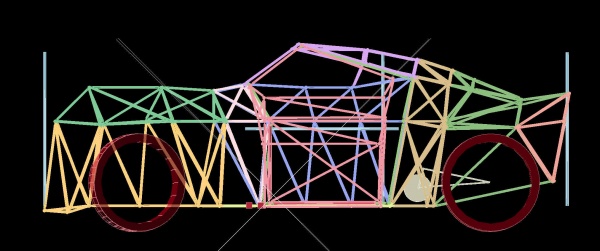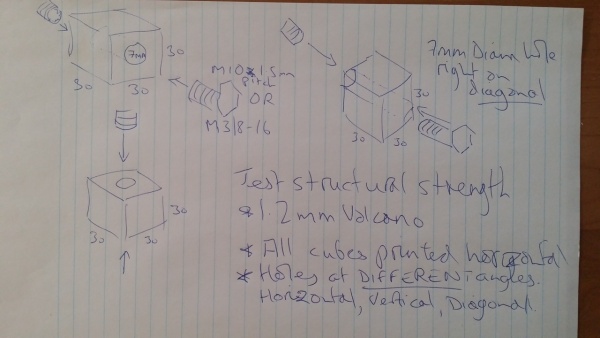UELVE MBC
UELVEs MBC
Intended as a lightweight proof of concept for further development of additional larger (and smaller) hybrid and tribrid electric vehicles.
Acronym decoding:
- UELVEs: Ultra-Efficient Libre Vehicles for Everyone.
- MBC: the Embassy, or the "MythBusters Car" (get it?), in honour of their discovery that a golf-ball texture on a car bodypanels significantly improves fuel economy. https://www.youtube.com/watch?v=VUiGhyHC-1A
Concept
Specifications
- 4 wheels using mountain bike 19in rims and 2.75/19 motorcycle tires (26in outer diameter)
- 100kg weight (full, complete vehicle)
- 2 occupants
- Twin 3-5kW Axial Flux BLDC chain-driven motors (no gearbox needed)
- 1.1 x 1.5 x 3.4 metre dimensions with an "airbox" down the centre
- Only a 1.1 m^2 front surface area (due to the "air tunnel")
- 0-60mph in under four seconds (Sur-Ron "3" kW Motors can be pushed to 13kW for short durations, and there's two of them)
- over 200mpg at 55mph due to low weight, low rolling resistance, reduced surface area and low drag coefficient.
- capable of driving up a 50% gradient at around 25mph with 2 occupants.
Notes
- While world records are held for under 3 seconds, under 4 seconds is close to world records. [1]. We can emphasize here that for "acceleration per horsepower", ours here is probably a world record. Luke - have you done the numbers on this one?
- with the simulator i wrote a few years ago, yes. link at bottom of page. it's the reduced weight, reduced drag coefficient and the SurRon axial flux motors which can do 13KW for short bursts that do it. the world record is an MIT team EV with 4 hub motors. 0 to 60 in 1.9 seconds. in the slo mo the walls of the tires actually buckle under the acceleration.
Correction: that MIT team has been beaten by AMZ, who officially managed 0 to 60 (100km/h) in 1.513 seconds
http://img.youtube.com/vi/n2XiCYA3C9s/default.jpg
Design Concept
- Use downhill mountain-bike parts that have been proven to be light, strong and effective up to a 50kg weight with an 80kg load, thanks to the Sur-Ron Electric Bike.
- Use twin Sur-Ron direct-drive 3-5kW Axial Flux electric motors
- Use twin ASI BAC4000 BLDC Controllers (or VESC Vedder BLDC Controllers http://vedder.se/2015/01/vesc-open-source-esc/)
- Outer skin using the GABoats technique (Geodesic Aerolite Boats) - http://gaboats.com
- Inner frame using 3D-printed fibre-reinforced "nodes" connecting continuous-fibre-reinforced pipes on a Fibre_Reinforced_Pipe_3D_Printer or getting carbon-fibre, hemp-reinforced tubes (or even Bamboo), based on the Divergent 3D "Blade" car manufacturing concept https://www.youtube.com/watch?v=vPv7PwS50OE
- Epoxy-soaked cloth "wrapping" carried out on joints, if necessary, using the Calfee Design Bamboo bike technique. https://calfeedesign.com/what-is-in-calfee-diy-kits/
- Swappable Modular batteries using the Open_Source_Battery_Pack
Source Code
- git clone http://lkcl.net/vehicle_3d/.git
TODO
this page.
Notes from Julia log
https://wiki.opensourceecology.org/wiki/ImplicitCAD#Julia
recycling fibre reinforced plastic, fibres get shorter and shorter. (solution: add more back in?)
carbon fibre eco hostile (not going to use carbon fibre, use hemp fibre or wood fibre, see Da Ai Technology in taiwan)
use detroit technique: 3 pieces, front middle and back. matches with what i suggested, given that big printer is aiming for 4x4x8 ft. roof and floor will probably need to be separate in this design (so, 4 pieces)
Material Strength Test
the logical reasoning behind this test is to find out if, with fibre-reinforced plastic, the layer adhesion affects strength of the part under load when bolts are screwed directly into it.
- two M10 1.5mm pitch bolts (or close: 3/8 with 1/16in pitch)
- a 30 x 30 x 30mm cube made of fibre reinforced plastic with a smooth cylinder hole down the middle about 7 or 7.5mm diameter
- print that using 100% infill, fibre reinforced plastic, with a minimum 0.8mm nozzle, preferably 1.2mm, with the hole pointing UPRIGHT.
- screw the two M10 bolts in, using the thread to "tap" the holes, making them meet in the middle
- hang it from a bench by 1 bolt and keep putting weights on it until it breaks.
i need to know, how much weight it took. it might be a lot, before the cube breaks or the threads strip.
the next test is printing it where the hole is horizontal.
the "more advanced" version of that is for the hole to be at 45 degrees through the cube, i.e to test the effect of diagonal layers.
Videos
http://img.youtube.com/vi/myu6vBy0ASs/0.jpg
See Also
Useful Links
- Simple Vehicle Simulator including gears, gear-changes, wind-resistance, rolling-resistance, gradients etc. http://lkcl.net/ev/vehicle_simulator/output/Simulator.html

